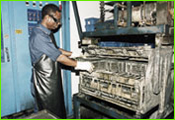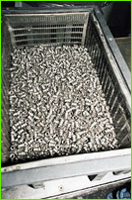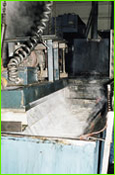DeltaGreen Concentrate
Simplifying Aqueous Cleaning
Fairchild Fasteners used practical experience and some help from its suppliers to replace several challenging cleaning operations with one process...
By Edward O'Neill,
Rigoberto Romo, and Alex Guzman,
Fairchild Fasteners; Masha Shub;
and Barbara Kanegsberg, BFK Solutions
Fairchild Fasteners is a growing company with a host of cleaning and surface preparation requirements. Recently, the company was motivated to change its cleaning methods. As a Title V facility, its South Bay Operations in Southern California wanted to eliminate methyl ethyl ketone and mineral spirits in favor of aqueous cleaning processes, even though South Coast Air Quality Management District regulations restrict VOCs for aqueous cleaning processes to 50 g/liter or less, with further reductions scheduled.
The South Bay Operations has shown significant advances in making aqueous cleaning practical and efficient, by tapping resources throughout the company. Most noteworthy, it used the expertise of experienced employees to full advantage and teamed with the cleaning agent supplier to cut process time and achieve its cleaning objectives without negatively affecting the product.
 |
| Fasteners are loaded into bins and then loaded into the cleaning station that is transferred from tank to tank. This minimizes operator handling and possible injury. |
Fairchild wanted to avoid the ordering and chemical handling hassles associated with using many types of cleaning agents by reducing the number of cleaning products from five to one. This is a challenge in aqueous cleaning because, unlike classic solvent-based cleaning, aqueous cleaning agents are often specific for a relatively narrow range of soils. Each process must be optimized to the soil and the metal. As a growing company, Fairchild insisted that processes be effective, rapid, robust, reliable and economical. Finally, the new processes must not introduce worker safety concerns or environmental problems.
Cleaning Agent Selection
In selecting this product over other aqueous cleaning agents tested, Fairchild considered performance, stewardship and ongoing product support. Efficacy of cleaning, cost and service were also important considerations. The product had to clean effectively under production conditions. Some of the cleaning products were relatively inexpensive per gallon of concentrate but could not be diluted as much for a given application. Others did not clean as effectively or rapidly in preliminary trials. Still others required frequent tank changeouts. The cleaning agent had to be adaptable to available equipment.
Employee safety was paramount, however. Fairchild wanted cleaning agents with the best safety and environmental attributes for its production environment. If an informative MSDS was not supplied, the product was rejected immediately. In this case, the ingredients list was not confidential, and an additives list was provided to the end user, providing an extra level of assurance.
 |
| Fairchild's personnel used to work with ambient cleaners, so a separate area was set up to allow parts to cool down prior to handling. |
Introducing the New Process
While a cleaning agent can appear to perform well under test conditions, and the costs and environmental profile may be favorable, none of this matters if the production people find it unacceptable. Therefore, the first step was to gain acceptance of the aqueous cleaning agents.
With any process change, there tends to be resistance. Although aqueous processes had been in use for some applications, many of the operators were particularly reluctant to convert from solvent-based to aqueous processes. Fairchild management decided that rather than having an engineering or safety/environmental group attempt to force-feed an imposed solution, process conversion was accomplished in a stepwise fashion, using a straightforward, honest approach with the active involvement of workers in individual departments. The success of the product in one area led to word-of-mouth recommendations in other areas at Fairchild.
Modifying processes, particularly changing from solvent to aqueous cleaning, required different ways of managing the production line. In this case, although the headquarters and main production facilities of the cleaning agent manufacturer are located in Gardena, CA, local formulation and technical capabilities were able to supply ongoing support to Fairchild. This support was particularly helpful during process startup and optimization.
The Tough Processes
Often, new approaches work well in a few relatively simple processes, but seemingly insurmountable roadblocks arise with the difficult processes. A direct, persistent approach, teaming an experienced operations technician with the cleaning agent supplier, allowed improvement of challenging processes.
The Tough Processes
Often, new approaches work well in a few relatively simple processes, but seemingly insurmountable roadblocks arise with the difficult processes. A direct, persistent approach, teaming an experienced operations technician with the cleaning agent supplier, allowed improvement of challenging processes.
| TABLE I—Three-Stage Immersion Cleaning Sequence | |||
| Tank Cleaning 1 Cleaning 2 Cleaning 3 Hot Air Dryer |
Gallons Concentrate (400 gal Total) 40 30 20 NA |
Temperature (F) 175 185 165 175 |
Time (min) 6-8 3 3 10 |
In one particular area, the lead plating technician was faced with an especially difficult assortment of cleaning applications and the need to monitor and control an array of different cleaning processes. The selected cleaning agent replaced an assortment of processes. Oils of varying consistency had to be removed from bolts, pins, nuts and washers. Another aqueous cleaning agent with a butyl cellosolve-based additive package required a 30-min cleaning cycle. A salt-based aqueous cleaning agent did not provide adequate cleaning. In another application, a VOC-exempt solvent was used to remove baked on, blackened lubricant from stainless steel parts. Given the cost of the solvent, several aqueous cleaning agents were tested initially without success. The cleaning agent selected to replace the assortment of cleaners Fairchild had been using, successfully removed the contaminants in 20 min.
In the case of the new cleaning process, the parts manufacturer and the cleaning agent manufacturer worked together to optimize concentration, temperature and process time to achieve cleanliness and provide adequate rust inhibitor in the final tank without wasting cleaning concentrate. During pilot runs in improvised containers (heated barrels), process variables were set up for manufacturing without interrupting product flow.
The results were a basic three-stage immersion cleaning process using increasingly dilute cleaning agent in tap water, which is outlined in Table I. Cleanliness is judged visually and by acceptability of parts for subsequent processes, such as plating. The process is run 24 hours per day, 7 days per week, with make-up water added daily. Ten gal of concentrate are added to the first tank and 5 gal to the second and third tanks twice weekly. The cleaning agent is changed monthly but can handle twice the throughput of the former process. With previous aqueous cleaners, the baths required a total changeout every 7-10 days.
As with all aqueous processes, it is important to provide adequate cleaning action. At Fairchild, cleaning action is enhanced by:
- Parts rotation (approximately 10 rpm);
- Below-surface jets; and
- Buffing/scrubbing rags that are cycled along with the parts.
The process is automated, with an overhead hoist handling parts during cleaning and drying. This provides a more consistent process than hand cleaning with less operator involvement.
 |
| Fairchild's South Bay Operation's hot cleaning bath removes oil, grease and other contaminants using an aqueous solution specifically designed to work on these parts. |
Practical Advice
The lead technician contributed invaluable practical advice, which was adaptable to many production lines at the plant, on achieving a successful process. For example, the fixture design must be matched to the part and the cleaning needs. With larger parts, baskets with as wide a mesh as possible proved most effective in removing metal chips. Baskets with a finer mesh are used to contain smaller parts, and an assortment of different sized baskets is available to optimize throughput. In addition, the sample load in each basket must be adjusted to allow adequate tumbling during the cleaning operation. Baskets are typically loaded to approximately one-fourth capacity. Packing too many samples into the baskets results in inadequate cleaning.
Adequate time must be provided for effective removal of oil residues. For Fairchild’s applications, the typical cleaning and drying time is 25 min, with 28 min needed for heavily soiled parts. Part of educating new operators involves assuring that the cleaning time is adequate. Although the cleaning agent is relatively mild, given the high temperatures and the heavy equipment in use, gloves are routinely used. Finally, in scheduling the workload, operations personnel, accustomed to cleaning at ambient temperature, have to remember to allow adequate time for the freshly cleaned and dried parts to cool down; therefore, a separate holding area is set up.
This three-tank process proved successful for removing a variety of oils and greases from stainless steel, carbon steel and titanium parts. However, understanding system limitations was crucial to success. For example, aluminum parts turned black when cleaned at the higher temperature. The problem was resolved by setting up a separate cleaning bath with the temperature reduced to 140F. In addition, some heavy, threaded parts bump into each other and become damaged if cleaned with rotation. Those parts had to be cleaned in a centrifugal cleaning unit or an immersion bath with agitation.
It seemed as if every production line had at least some parts that were a perennial cleaning headache.
The Greatest Cleaning Challenge
The three-tank aqueous process proved successful in what was considered to be the most difficult soil-removal process in the facility, thanks to a bit of persistence and ingenuity. The forged collar parts were complex 303 stainless and A286 aluminum components coated with large amounts of a heavy lubricant. After cleaning, the parts were acid-stripped and plated. Inadequately cleaned parts did not plate well.
The previous cleaning process involved hand-scrubbing each part with a brush using mineral spirits in a drum-mounted parts washer. The process was slow, labor-intensive and not effective in removing the residue. Other aqueous processes did not remove enough of the residue to satisfy subsequent manufacturing requirements.
While the selected cleaning agent successfully removed the residues initially, the process time was extremely long. The cleanroom operator was able to decrease the process time to 10 min in the initial tank by adding buffing/scrubbing rags to the baskets of parts. As the baskets of parts rotate, the rags provide additional cleaning action.
Several benefits were realized by adopting the aqueous system:
Difficult, unpleasant, ineffective hand brushing in mineral spirits was eliminated.
The number of manually operated pieces of equipment was reduced from four to zero.
The number of operators needed was reduced from two to one.
Fairchild was able to accomplish these changes despite the difficulty associated with process change and the stringent regulatory environment. The goals and their impact that lead to its success are summarized in the following Table II.
TABLE II
Major Goals - Aqueous Conversion and Product Consolidation Goal Impact
GOAL |
IMPACT |
| Replace methyl ethyl ketone, mineral spirits and eliminate VOCs | Improved reaulatory status; compliance with Title V and local air quality requlations |
| Adopt Aqueous Cleaning | Improved Safety and environmental profile |
| Minimize diversity of cleaning agents | Improved process control; simplicity in chemical ordering, storage and disposal |
| Compare additive packages for aqueous cleaning agents | Minimize environmental and requlatory concentration; Maximize employee safety |
| Compare dilution and bath life for aqueous cleaning agents | Cost savings; minimize waste handling |
| Involve cleaning agent vendor | Process support; assistance in troubleshooting |
| Achieve buy-in from production personnel | Process acceptance |
There is no universal solvent and no perfect cleaning method. Every cleaning approach, every process comes with some baggage in terms of environmental requirements and/or employee health and safety issues. Fairchild chose the method that would best meet its production and regulatory requirements. In addition, it did a great deal of up-front evaluation of cleaning agent vendors, insisting on a suitable environmental and safety profile, responsible product stewardship and a product that removes a broad spectrum of soils.
Determining the relative costs of cleaning processes is very complex. Achieving efficient cleaning without destroying the part is another matter. Determining compatibility with materials of construction can be estimated from studies with coupons, but it ultimately must be confirmed in a production situation. In addition, if the cleaning agent is useful for a wide range of soils, chemical handling and process development in the plant are simplified.
Since the fall of 1998, Fairchild has converted a surprisingly wide range of cleaning activities to a single cleaning agent. Because cleaning is effective and convenient with no unpleasant odor, there has been favorable employee acceptance. The formulation has successfully replaced a butyl cellosolve aqueous cleaner, a bicarbonate-based aqueous cleaner and a mineral spirits cleaning process. Fairchild is attempting to increase the number of areas where the selected cleaning agent is used. In expanding the use of the product to eliminate acid cleaning prior to plating and in other processes that could be considered precision cleaning, controlled rinsing is likely to be required.
By critically evaluating the cleaning options, using a team approach, including production people and cleaning agent vendors on the team, determining effectiveness and total costs and optimizing the process by production, Fairchild has been able to implement environmentally preferred aqueous processes and has made significant strides in process optimization with substantial cost savings.
REFERENCES
- Agopovich, J.W. “Evaluation of Non-Ozone Depleting Cleaning Solvents in Inertial Instrument Production,” Joint Services Data Exchange for Guidance, Navigation and Control, Palm Springs, CA, October 26-29, 1992.
- Kanegsberg, B. “Aqueous Cleaning in Perspective: Where You Should Use Water-Based Cleaning, Where You Should Use Something Else,” Third Annual Pollution Prevention Conference, Jacksonville, FL, June 10, 1999.
- Kanegsberg, B. and C. LeBlanc, TURI, “The Cost of Process Conversion,” CleanTech ’99, Rosemont, IL, May 1999.
- Kanegsberg, B., “How to Get Vendors to Work with You,” Precision Cleaning ’97, Cincinnati, OH, April 15 - 17, 1997.
- Kanegsberg, B., “Resolving Compatibility Issues with Aqueous Cleaning of Ferrous Metals, Specialty Alloys, and Complex Composites,” 1995 International CFC and Halon Alternatives Conference and Exhibition, Washington, D.C, October 26, 1995.
- Maluso, P. and B. Kanegsberg, “Hydrostatic Pump Rebuild: Implementing Aqueous, Steam and Solvent Free Processes,” Tenth Annual International Workshop on Solvent Substitution and the Elimination of Toxic Substances & Emissions, Scottsdale, AZ, September 13 – 16, 1999.
- O’Neill et al., “Four Steps to Process Conversion,” Parts Cleaning Magazine, Vol. IV, March 2000.
- Home
- About us
- DeltaGreen DG-300
- Dilution Ratios (pdf)
- Degreasing Applications (pdf)
- Partners
- Parts Cleaning
- Products
- Safety
- Special Offers
- Site Map
- Customers
- Contact
![]()


- CERTIFICATIONS
- MSDS
- WASTE PROTOCOL
- CUSTOMER LIST
- All Purpose Cleaner
- Aircraft Exterior Cleaner
- Aircraft Interior Cleaner
- Asphalt Release
- Floor Care Products
- Glass Cleaner
- Graffiti Remover
- Hand Soap
- Lime Scale Remover
- Lube 3000
- Oil Spot Remover
- PM-10-50
- Soy TA-100
- Stainless Steel Cleaner
- Tanker Clean 025
- Tar Remover
- Tire Shine
- Waterless Carwash
- Waterless Hand Cleaner
PRODUCTS: